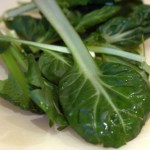Tatsoi has a ton of different names, spellings, and pronunciations. Tat soi, Chinese flat cabbage, spoon mustard, and rosette pakchoi are all things you may see tatsoi called too. But you’ll know what it is when you see it. Tatsoi is identifiable by its dark green spoon-shaped leaves. When growing, it forms a thick rosette, which explains one of the more unusual names it is called.
The high nutritional value is the number one reason to incorporate it into your diet. It’s chock full of vitamin C, folic acid, calcium, potassium, and carotenoids. It can be hard to start adding “weird” greens into your diet, no matter how adventurous of an eater you are, which is why I like to introduce them to people (and myself) in a much more familiar format, like pesto.
Pesto is traditionally made with just basil as the base green, but you can sub in about half of any mild flavored green for a pesto that won’t confuse the taste buds. Mustard green pesto might be a little overpowering, but tatsoi has a mild taste that makes it the perfect add in to pesto. This year I wanted to use tatsoi in a different way, so I combined it with my need to harvest lots of basil from the two overactive basil plants I put in my herb garden a few weeks ago so here we have tatsoi pesto!
Tat Soi and Basil Pesto
Equipment
- Food processor
Ingredients
- 2 cups tatsoi
- 1 clove garlic
- 1 cup fresh basil
- 1/4 cup pine nuts or walnuts
- 1/4 cup Parmesan or pecorino cheese grated
- 1-2 tbsp olive oil
- salt to taste
Instructions
- If you haven’t already, remove most of them stems from the leaves. Don’t worry about being too precise.
- Throw everything but the olive oil in a food processor.
- Turn it on and if you have the option to drizzle in the oil while the machine is running, add it slowly until the pesto is a spreadable consistency. If you don’t have the luxury of the feature, add one tablespoon of oil, blend, then add the rest as needed.
- Salt to taste or add a little more cheese.
If you’re a gardener, tatsoi is also an easy green to grow, especially in colder zones. It can survive in as low as 15 degrees F, and can be harvested from underneath snow, a problem I don’t think I’ll ever have here in South Carolina.
Tat soi is easily identifiable by its large, shiny spoon shaped leaves and dark green color that lets you know how rich in vitamin A, K, and C. You may be wondering how you can measure those big leaves, so here’s how- stack them in the measuring cup and push them down a bit with your fingers. Then pry them out to toss in the food processor.
Then make it even better by putting it over pasta. I also added marinara sauce, pine nuts, and more cheese on top! You can hardly tell that there are Chinese greens in this very Italian-American pasta dish.
Tatsoi basil pesto keeps for about two weeks in the fridge. Once you scoop it into a container with a tight-fitting lid, drizzle a bit of olive oil over the top to keep the top layer of pesto from oxidizing from exposure to the air in the container. If your container lid allows, try to burp out some of the air to keep your pesto fresher for longer.


